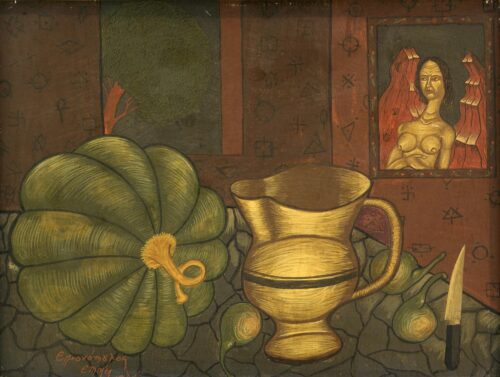
Engonopoulos Nicos (1907 - 1985)
Theatre, 1961
“He studied at the Athens School of Fine Arts under professors Konstantinos Parthenis, Dimitrios Biskinis, Thomas Thomopoulos and Yannis Kefallinos. After his graduation in 1938, he worked with the painter Evangelos Ioannidis; thanks to his apprenticeship under Fotis Kontoglou and professor Alexandros Xyngopoulos, he was exposed to the tradition and the spirit of the Byzantine and post-Byzantine art. Along with Yannis Tsarouchis, he worked as assistant for the monumental mural that Kontoglou made in his house, today in the National Gallery. He travelled in many European countries and made independent art studies in Munich and cities in Italy. On his return to Greece, he worked as teacher for many years, while in 1967 was appointed professor of painting at the School of Architecture, National Technical University of Athens, where he had worked as lecturer since the late 1930s.
As early as the pre-war years, he had shown his works of painting at a solo exhibition, organised at the house of N. Kalamaris (1939), causing extreme reactions by the critics. A series of solo and group exhibitions followed in Greece and other countries. One year earlier, in 1938, his first poetry collection, entitled “”Μην ομιλείτε εις τον οδηγόν”” was published by Kyklos Publications, while in 1939 “”Κλειδοκύμβαλα της σιωπής”” came out. In 1954, he exclusively represented Greece at the Biennale of Venice with one hundred of his works, and one year later, he participated in the Biennale of Sao Paulo. He also participated in all the exhibitions of the group “Armos,” of which he was founding member (1964). In 1958, he received the First Poetry Award of the Hellenic Ministry of Education, and in 1966 received the Golden Cross of George I for his oeuvre of painting. Retrospective exhibitions of his work were organised at the Moraitis Educational Society in 1977 and the National Gallery in 1983. He also produced set designs for the theatre and illustrations for books.
The introducer and principal exponent of Surrealism in Greece, member of the so-called Generation of the Thirties, he combined elements and iconography from a great span of the Greek tradition, from mythology and antiquity to Byzantium, modern times and the contemporary period, in an unconventional fashion, in an often bitterly ironic or humorous vein. Evident in his paintings is an erotic mood, incarnated in the male and female nude figures that inhabit them. He stressed the formative influence exerted on his work by the art of his teachers, Parthenis and Kontoglou, as well as by his acquaintance with the poet Andreas Empeirikos and the pre-eminent representative of metaphysical painting, Giorgio de Chirico. Thanks to his painting and poetry, Engonopoulos, a man of a wide-ranging culture, is among the great intellectual figures of post-War Greece. “

Theatre, 1961

Still Life, 1936

Poet and Muse, 1938

Delos, 20th century

Mock-up for the play “Caesar and Cleopatra”, 1962

Mock-up for the play “Caesar and Cleopatra”, 1962

Mock-up for the play “Caesar and Cleopatra”, 1962

Anthemius of Tralles and Isidore of Miletos, 1970

We use cookies to make our site work properly, to personalize content and ads, to provide social media features and to analyze our traffic. We also share information about how you use our site with our social media, advertising and analytics partners. Read the Cookies Policy.
These cookies are necessary for the website to function and cannot be switched off in our systems. They are usually only set in response to actions made by you which amount to a request for services, such as setting your privacy preferences, logging in or filling in forms. You can set your browser to block or alert you about these cookies, but some parts of the site will not then work. These cookies do not store any personally identifiable information.
If you disable this cookie, we will not be able to save your preferences. This means that every time you visit this website you will need to enable or disable cookies again.
These cookies tell us about how you use the site and they help us to make it better. For example these cookies count the number of visitors to our website and see how visitors move around when they are using it. This helps us to improve the way our site works, for example, by ensuring that users find what they are looking for easily. Our website uses Google Analytics for statistics reporting.
Please enable Strictly Necessary Cookies first so that we can save your preferences!